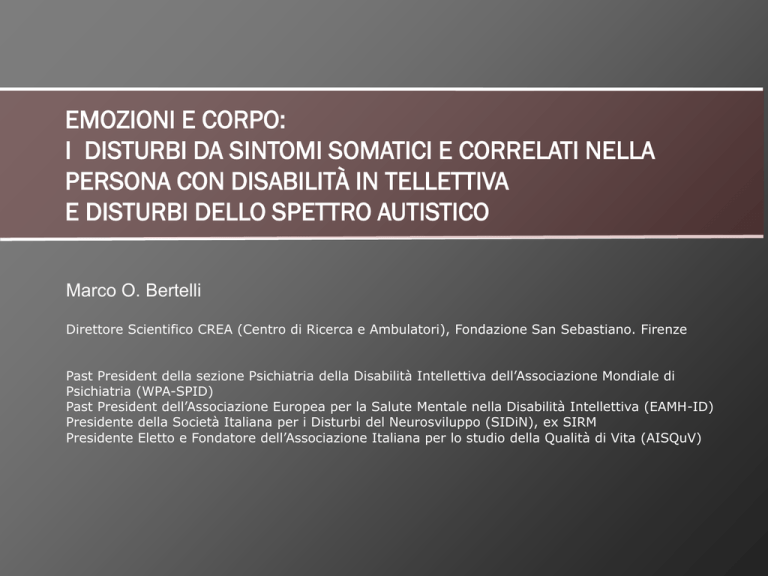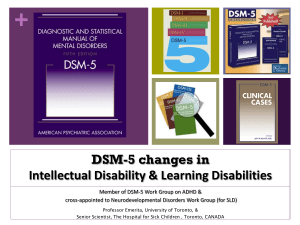
EMOZIONI E CORPO:
I DISTURBI DA SINTOMI SOMATICI E CORRELATI NELLA
PERSONA CON DISABILITÀ IN TELLETTIVA
E DISTURBI DELLO SPETTRO AUTISTICO
Marco O. Bertelli
Direttore Scientifico CREA (Centro di Ricerca e Ambulatori), Fondazione San Sebastiano. Firenze
Past President della sezione Psichiatria della Disabilità Intellettiva dell’Associazione Mondiale di
Psichiatria (WPA-SPID)
Past President dell’Associazione Europea per la Salute Mentale nella Disabilità Intellettiva (EAMH-ID)
Presidente della Società Italiana per i Disturbi del Neurosviluppo (SIDiN), ex SIRM
Presidente Eletto e Fondatore dell’Associazione Italiana per lo studio della Qualità di Vita (AISQuV)
DISTURBI DA SINTOMI SOMATICI E CORRELATI
DSM-5
somatic symptom disorder
illness anxiety disorder
conversion disorder (functional neurological
symptom disorder)
psychological factors affecting other medical
conditions
factitious disorder
other specified somatic symptom and related
disorder
unspecified somatic symptom and related disorder
APA, 2013
DISTURBO DA SINTOMI SOMATICI - CRITERI DM-ID 2
DSM-5 Criteria
Adapted Criteria for Mild/Moderate Adapted Criteria for
ID
Severe/Profound ID
A. One or more somatic
symptoms that are
distressing or result in
significant disruption of
daily life.
A. One or more somatic symptoms that
are distressing or result in significant
disruption of daily life or result in
treatment being sought or significant
impairment in social, occupational, or
other important areas of common
behaviors and functioning, including
daily living skills, usual activities, and
routines.
NOTE: A person with ID might not
complain verbally but might
demonstrate through behaviour that he
or she has pain or other bodily
symptoms. The individual with ID
might not have the independence or
capacity to seek medical treatment;
however, the symptoms and behaviour
will gain the attention of caregivers. It is
usually another person who seeks
treatment for the individual with ID,
and that person’s motivation and timing
might complicate the diagnostic
assessment.
Bertelli et al. Diagnostic Manual - Intellectual Disability II. NADD, in press
A. One or more somatic symptoms that
result in significant disruption of daily
life or result in treatment being sought or
significant impairment in social,
occupational, or other important areas of
common behaviors and functioning,
including daily living skills, usual
activities, and routines.
DISTURBO DA SINTOMI SOMATICI - CRITERI DM-ID 2
DSM-5 Criteria
Adapted Criteria for
Mild/Moderate ID
Adapted Criteria for
Severe/Profound ID
A.
Specify if:
with predominant pain
(previously pain disorder).
This specifier is for
individuals whose somatic
symptoms predominantly
involve pain.
No adaptation.
NOTE: In persons with little or
no language and communication
ability, it is usually very difficult
to assess this specifier.
Nevertheless, people sometimes
communicate that they feel pain
in a part of the body by
indicating it or touching it with
their own hand or somebody
else's hand.
Bertelli et al. Diagnostic Manual - Intellectual Disability II. NADD, in press
DISTURBO DA SINTOMI SOMATICI - CRITERI DM-ID 2
DSM-5 Criteria
Adapted Criteria for
Mild/Moderate ID
Adapted Criteria for Severe/Profound ID
B. Excessive thoughts,
feelings, or behaviors
related to the somatic
symptoms or associated
health concerns as
manifested by at least one
of the following:
1) Disproportionate and
persistent thoughts about
the seriousness of one’s
symptoms.
No adaptation.
Excessive behavior related to the somatic symptoms or
associated health concerns as manifested by at least one
of the following:
No adaptation.
NOTE: In persons with little or no language and
communication ability, it is usually not possible to assess
this specifier.
Nevertheless, preoccupations may be expressed as
behavioral changes, with the person appearing to be
frightened, agitated or distressed.
2) Persistently high level
of anxiety about health or
symptoms.
No adaptation.
NOTE: In persons with little or no language and
communication ability, anxiety may be observed rather
than self-reported.
Commonly the person appears to be frightened, agitated
or distressed.
3) Excessive time and
energy devoted to these
symptoms or health
concerns.
No adaptation.
No adaptation.
Bertelli et al. Diagnostic Manual - Intellectual Disability II. NADD, in press
DISTURBO DA SINTOMI SOMATICI - CRITERI DM-ID 2
DSM-5 Criteria
Adapted Criteria for Adapted Criteria for Severe/Profound
Mild/Moderate ID
ID
C. Although any one somatic symptom
No adaptation.
may not be continuously present, the state
of being
symptomatic is persistent (typically more
than 6 months).
No adaptation.
Specify if:
Persistent: a persistent course is
characterized by severe symptoms,
marked impairment, and long duration
(more than 6 months).
No adaptation.
No adaptation.
Specify current severity:
Mild: Only one of the symptoms specified
in Criterion B is fulfilled.
Moderate: Two or more of the symptoms
specified in Criterion B are fulfilled.
Severe: Two or more of the symptoms
specified in Criterion B are fulfilled, plus
there
are multiple somatic complaints (or one
very severe somatic symptom).
No adaptation.
Specify current severity:
Mild/Moderate: only the symptoms 1 or 2
specified in Criterion B are fulfilled.
Severe: all the symptoms specified in
Criterion B are fulfilled, plus there
are behavioural signs (see above) of
multiple somatic complaints (or one very
severe somatic symptom behaviour).
Bertelli et al. Diagnostic Manual - Intellectual Disability II. NADD, in press
DISTURBO DA ANSIA SOMATICA - CRITERI DM-ID 2
DSM-5 Criteria
Adapted Criteria for
Mild/Moderate ID
Adapted Criteria for Severe/Profound
ID
A. Preoccupation with
having or acquiring a
serious illness.
No adaptation.
NOTE: A person have more
limited ability to verbally
communicate his or her concern
and preoccupation, but this
might manifest as repetitive
behavior, such as checking in a
mirror or pointing at a minor
skin blemish, or preoccupation
with medical equipment such
as a thermometer or bandage.
NOTE: In persons with little or no
language and communication ability, it
is usually not possible to identify this
symptom.
Nevertheless, preoccupation may be
expressed as behavioral changes
directed at a bodily abnormality such as
a bruise or skin blemish or medical
equipment such as a thermometer or
bandage, and with the person
appearing to be frightened, agitated or
distressed.
Bertelli et al. Diagnostic Manual - Intellectual Disability II. NADD, in press
DISTURBO DA ANSIA SOMATICA - CRITERI DM-ID 2
DSM-5 Criteria
Adapted Criteria for
Mild/Moderate ID
Adapted Criteria for Severe/Profound
ID
B. Somatic symptoms are
not present or, if present,
are only mild in
intensity. If another
medical condition is
present or there is a high
risk for developing a
medical condition (e.g.,
strong family history is
present), the
preoccupation is clearly
excessive or
disproportionate.
No adaptation.
NOTE. Somatic symptoms may result in
significant disruption of daily life or in
treatment being sought or significant
changes in social, occupational, or other
important areas of common behaviors
and functioning, including daily living
skills, usual activities, and routines.
NOTE: Limited or distorted
knowledge and comprehension
can complicate the process of
reassuring a person with ID.
Simple language, the use of
visual means of
communication, the
involvement of relatives or
caregivers, and the provision of
physical comfort might help to
confirm if reassurance is
possible.
Bertelli et al. Diagnostic Manual - Intellectual Disability II. NADD, in press
DISTURBO DA ANSIA SOMATICA - CRITERI DM-ID 2
DSM-5 Criteria
C.
There is a high level of
anxiety about health,
and the individual is
easily alarmed about
personal health status.
Adapted Criteria for
Mild/Moderate ID
Adapted Criteria for Severe/Profound
ID
NOTE: In persons with little or no
language and communication ability, it
NOTE: In comparison with
is usually not possible to identify this
neurotypical individuals,
symptom.
persons with ID are likely to
Nevertheless, anxiety and
have progressively less insight preoccupation may be expressed as
as the level of ID increases.
behavioral changes, with the person
However, it might be possible
appearing to be frightened, agitated or
to comment on the current level distressed.
of insight relative to the
individual’s premorbid level of
understanding about serious
illness.
C. No adaptation.
Bertelli et al. Diagnostic Manual - Intellectual Disability II. NADD, in press
DISTURBO DA ANSIA SOMATICA - CRITERI DM-ID 2
DSM-5 Criteria
Adapted Criteria for
Mild/Moderate ID
Adapted Criteria for Severe/Profound
ID
D. The individual performs
excessive health-related
behaviors (e.g. repeatedly
checks his or her body for
signs of illness) or exhibits
maladaptive avoidance
(e.g., avoids doctors
appointments and
hospitals).
D. No adaptation.
D. No adaptation.
E. Illness preoccupation has
been present for at least 6
months, but the specific
illness that is feared may
change over that period of
time.
E. Since there is a likelihood of
frequent atypical presentation
and
difficulties in early
identification, the length of
illness preoccupation can be
lower than 6 months, but still
should be present for a period
of at least 3 months.
E. Since the difficulties in early
identification, the length of illness
preoccupation can be lower than 6
months, but still present for a period of
at least 3 months.
Bertelli et al. Diagnostic Manual - Intellectual Disability II. NADD, in press
DISTURBO DA ANSIA SOMATICA - CRITERI DM-ID 2
DSM-5 Criteria
Adapted Criteria for
Mild/Moderate ID
Adapted Criteria for
Severe/Profound ID
F. The illness-related preoccupation is not better
explained by another medical disorder, such as
somatic symptom disorder, panic disorder,
generalized anxiety disorder, body dysmorphic
disorder, obsessive-compulsive disorder, or
delusional disorder, somatic type.
F. No adaptation.
F. No adaptation.
Specify whether: Care-seeking type: medical
care, including physician visits or undergoing
tests and procedures, is frequently used.
Care-avoidant type: medical care is rarely used.
No adaptation.
NOTE: See A.
Bertelli et al. Diagnostic Manual - Intellectual Disability II. NADD, in press
No adaptation.
NOTE: See A.
DISTURBO DA CONVERSIONE- CRITERI DM-ID 2
(Disturbo da sintomi neurologici funzionali)
Adapted Criteria for
Mild/Moderate ID
One or more
A. No adaptation.
symptoms of altered NOTE: A person with ID
voluntary motor or
might not complain
sensory function.
verbally but might
demonstrate through
behavior that he or she has
a bodily symptom. The
individual with ID might
not have the independence
or capacity to seek medical
treatment; however, the
symptoms and behavior
will gain the attention of
caregivers.
DSM-5 Criteria
A.
Bertelli et al. Diagnostic Manual - Intellectual Disability II. NADD, in press
Adapted Criteria for
Severe/Profound ID
A. No adaptation.
NOTE: Persons with little or no
language and communication
ability, demonstrate through
behavior that they have a bodily
symptom.
Individual with severe ID have not
the independence or capacity to
seek medical treatment; however,
the symptoms and behavior
usually gain the attention of
caregivers.
DISTURBO DA CONVERSIONE- CRITERI DM-ID 2
DSM-5 Criteria
Adapted Criteria for
Mild/Moderate ID
Adapted Criteria for
Severe/Profound ID
B. Clinical findings provide evidence
of incompatibility between the
symptom and recognized
neurological or medical conditions.
B. No adaptation.
B. No adaptation.
C. The symptom or deficit is not
C. No adaptation.
better explained by another medical
or mental disorder.
C. No adaptation.
Bertelli et al. Diagnostic Manual - Intellectual Disability II. NADD, in press
DISTURBO DA CONVERSIONE- CRITERI DM-ID 2
DSM-5 Criteria
Adapted Criteria for
Mild/Moderate ID
Adapted Criteria for
Severe/Profound ID
Specify symptom type:
with weakness or paralysis
with abnormal movement (e.g. tremor, dystonic
movement, myoclonus, gait disorder)
with swallowing symptoms
with speech symptom (e.g. dysphonia, slurred
speech)
with attacks or seizures
with anaesthesia or sensory loss
with special sensory symptom (e.g. visual,
olfactory, or hearing disturbance)
with mixed symptoms.
Specify if:
Acute episode: symptoms present for less than 6
months.
Persistent: Symptoms occurring for 6 months or
more.
No adaptation.
No adaptation.
Since there is a
likelihood of frequent
atypical presentation
and difficulties in early
identification, the
length of illness
preoccupation can be
lower than 6 months,
but still present for
period of at least 3
months.
Since the difficulties in
early identification, the
length of illness
preoccupation can be
lower than 6 months, but
still present for a period of
at least 3 months.
DISTURBO FITTIZIO - CRITERI DM-ID 2
DSM-5 Criteria
Adapted Criteria for
Mild/Moderate ID
Adapted Criteria for
Severe/Profound ID
A. Falsification of physical or psychological
signs or symptoms, or induction of
injury or disease, associated with
identified deception.
A. No adaptation
A.
NOTE: It might be difficult
to assess intention and
motivation in persons with
limited language and
communication ability.
However, if the repeated
consequence of symptoms
that are shown not to have a
medical cause is the
achievement of a sick role,
then the criterion is
indicated.
NOTE: In persons with
little or no language and
communication ability, it
is usually not possible to
assess this criterion.
B. The individual presents himself or herself B. No adaptation.
to others as ill, impaired, or injured.
NOTE: See A.
Bertelli et al. Diagnostic Manual - Intellectual Disability II. NADD, in press
B.
NOTE: See A.
DISTURBO FITTIZIO - CRITERI DM-ID 2
DSM-5 Criteria
Adapted Criteria for
Mild/Moderate ID
C. The deceptive behavior is evident
even in the absence of obvious
external rewards.
C. The deceptive behavior is
C.
evident even in the absence of
Note: See A.
external rewards (such as economic
gain, avoiding legal responsibility,
achieving a favorite activity,
avoiding a disliked activity, or
improving well-being).
D. The behavior is not better explained by D. No adaptation.
another mental disorder, such as
delusional disorder or another psychotic
disorder.
Bertelli et al. Diagnostic Manual - Intellectual Disability II. NADD, in press
Adapted Criteria for
Severe/Profound ID
D.
Note: See A.
DISTURBO FITTIZIO AD ALTRO - CRITERI DM-ID 2
DSM-5 Criteria
A.
Falsification of
physical or
psychological signs or
symptoms, or
induction of injury or
disease, in another,
associated with
identified deception.
Adapted Criteria for
Mild/Moderate ID
A. No adaptation
Adapted Criteria for
Severe/Profound ID
A.
NOTE: Diagnosis is possible
only in those individuals with
mild ID who are able to have
another person under their care.
It might be difficult to assess
intention and motivation in
persons with limited language
and communication ability.
However, if the repeated
consequence of symptoms that
are shown not to have a medical
cause is the achievement of a
sick role, then the criterion is
indicated.
NOTE: In persons with
little or no language and
communication ability who
are not likely to be
responsible for the care of
another it is not possible to
make tis diagnosis.
Bertelli et al. Diagnostic Manual - Intellectual Disability II. NADD, in press
DISTURBO FITTIZIO AD ALTRO - CRITERI DM-ID 2
DSM-5 Criteria
Adapted Criteria for
Mild/Moderate ID
Adapted Criteria for
Severe/Profound ID
B. The individual presents another
individual (victim) to others as ill,
impaired, or injured.
B. No adaptation.
B.
NOTE: See A.
NOTE: See A.
C. The deceptive behavior is
evident even in the absence of
obvious external rewards.
C. The deceptive behavior is evident
even in the absence of external rewards
(such as economic gain, avoiding legal
responsibility, achieving a favorite
activity, avoiding a disliked activity, or
improving well-being).
D. No adaptation.
C.
NOTE: See A.
D. The behavior is not better
explained by another mental
disorder, such as delusional disorder
or another psychotic disorder.
No adaptation.
Specify:
Single episode
Recurrent episodes (two or more
events of falsification of illness
and/or induction of injury)
Bertelli et al. Diagnostic Manual - Intellectual Disability II. NADD, in press
D.
NOTE; See A.
NOTE : See A.
Marco Bertelli
Psichiatra, psicoterapeuta
Direttore Scientifico CREA (Centro di Ricerca e Ambulatori), Fondazione San Sebastiano. Firenze
Past President della sezione Psichiatria della Disabilità Intellettiva dell’Associazione Mondiale di Psichiatria (WPASPID)
Past President dell’Associazione Europea per la Salute Mentale nella Disabilità Intellettiva (EAMH-ID)
Presidente della Società Italiana per i Disturbi del Neurosviluppo (SIDiN), ex SIRM
Presidente Eletto e Fondatore dell’Associazione Italiana per lo studio della Qualità di Vita (AISQuV)
CONTACT DETAILS:
[email protected]
[email protected]



